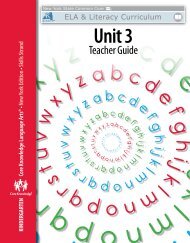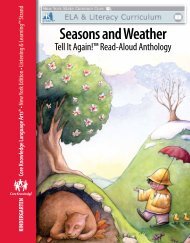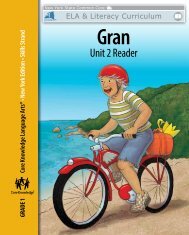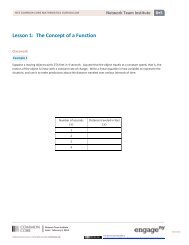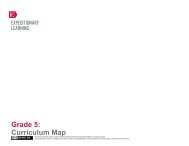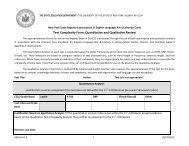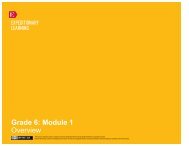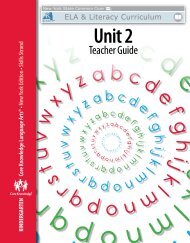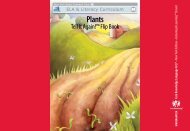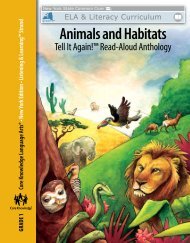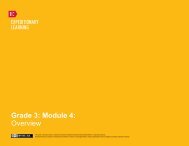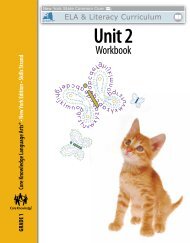Skills Unit 2 Teacher Guide - EngageNY
Skills Unit 2 Teacher Guide - EngageNY
Skills Unit 2 Teacher Guide - EngageNY
You also want an ePaper? Increase the reach of your titles
YUMPU automatically turns print PDFs into web optimized ePapers that Google loves.
Main Idea and Key Details: The main idea of the story is that a<br />
pancake comes to life while being prepared to feed children. The<br />
pancake runs away from everyone who is chasing it. The pancake’s<br />
success at elusion makes him boastful and overly confident. Key<br />
details of the text include the personification details of the pancake,<br />
the ever increasing number of people chasing the pancake and the<br />
pancake’s building certainty of escape and survival.<br />
<strong>Teacher</strong> Overview<br />
Synopsis: The story “The Pancake, Parts I and II” is a retelling of<br />
“The Gingerbread Man”.<br />
Text from Student Reader<br />
• The text of the Student<br />
Reader is reproduced<br />
here for your convenience.<br />
However, student referral<br />
to the text in front of them<br />
is a critical element of<br />
Close Reading.<br />
Page 54<br />
“Did you enjoy the tale of the<br />
hedgehog and the hare?” asked<br />
Mike’s dad. “Yes, I liked it,” said<br />
Mike. “The hedgehog came up<br />
with a good trick.” “The tale I’d<br />
like to tell you next has a trick<br />
in it, too.”<br />
“Cool!” said Mike. “Is there a<br />
hedgehog in it?”<br />
“Nope,” said his dad. “But there<br />
is a pancake in it!”<br />
“A pancake?”<br />
“Yep.”<br />
“Neat! Tell it!”<br />
“But the sun has not set yet!<br />
The street lamp is not on yet!”<br />
“Please! I would like to hear it!<br />
Will you tell the pancake tale!”<br />
Page 56<br />
Once upon a time there was<br />
a mom who had six kids. One<br />
morning the mom was grilling a<br />
pancake for the kids. The kids<br />
looked at the pancake. They got<br />
out their forks and started licking<br />
their lips. The pancake looked<br />
back at the kids. He was scared.<br />
He feared the kids would eat him.<br />
When the mom was not looking,<br />
the pancake jumped out of the<br />
pan and ran off.<br />
Vocabulary Instruction<br />
• As the text is read aloud,<br />
stop after each sentence<br />
containing targeted<br />
vocabulary to explain<br />
meanings or to check<br />
student understanding.<br />
Feared (Page 56) – to be afraid<br />
of something or someone<br />
Grilling (Page 56) – to cook<br />
over a flame<br />
Lesson<br />
Text Dependent Questions<br />
• After any targeted<br />
vocabulary has been<br />
defined and/or discussed,<br />
ask the text-based<br />
questions.<br />
• Begin with a “winnable”<br />
question that will help<br />
orient students to the text.<br />
• The sequence of questions<br />
should build a gradual<br />
understanding of the key<br />
details of the text.<br />
• Questions should focus on<br />
a word, phrase, sentence,<br />
or paragraph.<br />
How do you know this story will<br />
be the same genre as “How the<br />
Hedgehog Tricked the Hare”?<br />
What time of day is dad telling<br />
this story?<br />
In the second paragraph of<br />
page 56, read the parts of the<br />
story that let us know this is<br />
fiction.<br />
Responses<br />
• Answers should reference<br />
the text.<br />
• Multiple responses may be<br />
provided using different<br />
pieces of evidence.<br />
• Inferences must be<br />
grounded logically in the<br />
text.<br />
Mike’s dad says, “The tale I’d<br />
like to tell you next has a trick in<br />
it, too.” When we see the word<br />
too at the end of a sentence it<br />
means the same as also or in<br />
addition.<br />
It must be sometime during the<br />
day and it is not at bedtime.<br />
Dad says, “But the sun has not<br />
set yet! The street lamp is not<br />
on yet!”<br />
“The pancake looked back at<br />
the kids. He was scared. He<br />
feared the kids would eat him.<br />
The pancake jumped out of<br />
the pan and ran off.” We know<br />
this is personification because<br />
real pancakes don’t do these<br />
things. Personification, which<br />
means describing non-humans<br />
using human characteristics or<br />
qualities, is only used in fantasy<br />
stories.<br />
114 <strong>Unit</strong> 2 | Lesson 12<br />
© 2013 Core Knowledge Foundation



